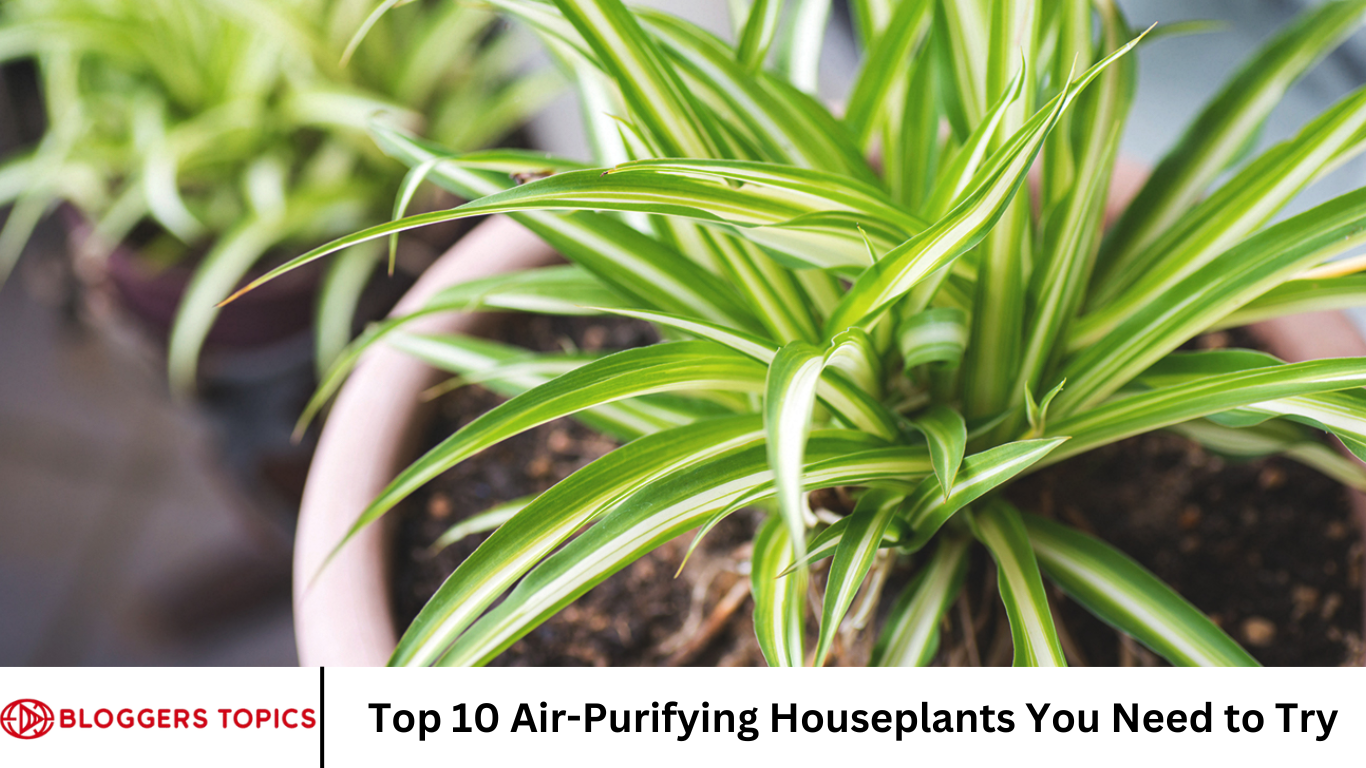Indoor air quality is a major concern for many people, particularly those living in urban areas or environments with poor ventilation. One of the most natural ways to improve the air inside your home is by bringing in houseplants.
Not only do they add a touch of nature and beauty to your living space, but they can also purify the air by removing harmful toxins and increasing oxygen levels. We’ll explore the top 10 air-purifying houseplants you should try, all of which are low-maintenance and perfect for beginners.
These plants work tirelessly to improve indoor air quality, while offering a variety of aesthetic and health benefits. From reducing harmful chemicals like formaldehyde and benzene to boosting humidity and promoting a sense of calm, these plants are must-haves for any home.
More Read: The Power of Less: Transform Your Home with Minimalist Decor
1. Spider Plant (Chlorophytum comosum)
Why It’s Great for Air Purification
The spider plant is one of the most popular air-purifying houseplants due to its ability to remove common indoor pollutants like formaldehyde and xylene. It also releases oxygen, making it a great plant to have in bedrooms and living spaces.
Care Tips
Spider plants are incredibly easy to care for and thrive in indirect light. They are tolerant of a range of temperatures, making them ideal for most indoor environments. Water them regularly but let the soil dry out between waterings. They prefer slightly dry conditions over too much moisture, so be careful not to overwater.
Fun Fact
Spider plants are known for their ability to propagate easily. Their “babies” or plantlets can be cut off and replanted, making them a fun and rewarding plant to grow.
2. Snake Plant (Sansevieria trifasciata)
Why It’s Great for Air Purification
The snake plant is an excellent air purifier, known for its ability to filter out formaldehyde, benzene, and other harmful toxins. It also absorbs carbon dioxide at night and releases oxygen, making it perfect for improving indoor air quality around the clock.
Care Tips
Snake plants are incredibly low-maintenance. They prefer indirect light but can also tolerate low-light conditions. Water them sparingly—only when the soil has dried out. Overwatering is one of the few ways this plant can suffer, so it’s important to keep it in well-drained soil.
Fun Fact
Snake plants are sometimes called “mother-in-law’s tongue” due to their long, pointed leaves. They are also one of the few plants that continue to produce oxygen at night.
3. Peace Lily (Spathiphyllum)
Why It’s Great for Air Purification
The peace lily is a top contender when it comes to purifying the air. It is known for its ability to remove formaldehyde, benzene, trichloroethylene, and ammonia from indoor environments. In addition to purifying the air, peace lilies also help increase humidity levels in dry environments.
Care Tips
Peace lilies thrive in low to moderate light and should be watered regularly, but make sure the soil drains well. They like their soil to be kept moist but not soggy. To encourage blooming, provide the peace lily with a bit of bright, indirect light and feed it with a balanced houseplant fertilizer.
Fun Fact
Peace lilies are not only great for air purification, but they also produce elegant white flowers that bloom throughout the year.
4. Aloe Vera (Aloe barbadensis miller)
Why It’s Great for Air Purification
Aloe vera is known for its medicinal properties, but it’s also an effective air purifier. It helps remove formaldehyde and benzene from the air. It’s also a natural humidifier, which is particularly helpful in dry environments.
Care Tips
Aloe vera plants require plenty of sunlight, so place them in a sunny windowsill. They prefer well-draining soil and should be watered only when the soil has dried out. Aloe vera is a succulent, so it doesn’t need frequent watering. Overwatering can lead to root rot, so be cautious.
Fun Fact
The gel inside aloe vera leaves has been used for centuries to treat skin burns, cuts, and irritations. It’s a multi-functional plant, providing both beauty and health benefits!
5. Areca Palm (Dypsis lutescens)
Why It’s Great for Air Purification
The Areca Palm, also known as the butterfly palm, is excellent at purifying the air by removing toxins like formaldehyde, xylene, and toluene. In addition to air-purifying benefits, it adds a tropical flair to your home.
Care Tips
Areca palms thrive in bright, indirect light and should be watered consistently but not excessively. Allow the soil to dry out a little between waterings. They prefer higher humidity, so you may need to mist the leaves occasionally or place them near a humidifier.
Fun Fact
Areca palms are fast growers and can reach up to 6 feet in height indoors, making them an attractive focal point in any room.
6. Rubber Plant (Ficus elastica)
Why It’s Great for Air Purification
The rubber plant is a powerful air purifier, effectively removing toxins such as formaldehyde from your indoor air. It is also known for its ability to thrive in low-light conditions, making it a great choice for less sunny rooms.
Care Tips
Rubber plants prefer bright, indirect light but can tolerate low light. Water them when the top of the soil feels dry to the touch. Make sure the pot has good drainage to prevent root rot. Rubber plants also benefit from occasional pruning to encourage bushier growth.
Fun Fact
Rubber plants have large, glossy leaves that can add a touch of elegance to any space. The plant’s thick leaves are great at trapping dust, further improving air quality.
7. English Ivy (Hedera helix)
Why It’s Great for Air Purification
English Ivy is a versatile air-purifying plant that can remove formaldehyde, benzene, and xylene from your home. It is particularly effective in kitchens and bathrooms, where it can help reduce mold and mildew.
Care Tips
English Ivy prefers moderate to bright light and should be watered regularly. However, let the soil dry out slightly between waterings. This plant is a climber, so providing it with a trellis or letting it trail from a hanging pot can make for an attractive display.
Fun Fact
English Ivy is great for reducing airborne mold particles, which is why it’s often recommended for areas with high humidity, such as bathrooms.
8. Bamboo Palm (Chamaedorea seifrizii)
Why It’s Great for Air Purification
The bamboo palm is an excellent choice for purifying the air, particularly in areas with high humidity. It can filter out chemicals like formaldehyde, benzene, and trichloroethylene. Plus, it adds a lush, tropical look to your home.
Care Tips
This plant prefers bright, indirect light and needs to be watered when the soil is dry to the touch. It’s important to avoid letting the bamboo palm sit in water, as this can cause root rot. Regular misting can help keep it healthy, especially in dry indoor environments.
Fun Fact
Bamboo palms are pet-friendly, making them a great choice for households with dogs and cats.
9. Chinese Evergreen (Aglaonema)
Why It’s Great for Air Purification
The Chinese Evergreen is a low-maintenance air-purifying plant that is particularly effective at removing toxins like formaldehyde and benzene from indoor air. It’s also one of the best plants for improving indoor humidity.
Care Tips
Chinese Evergreens thrive in low to moderate light conditions. Water them when the soil feels dry to the touch, but avoid overwatering. These plants can tolerate a range of indoor conditions, making them perfect for beginners.
Fun Fact
The Chinese Evergreen is known for its attractive, variegated leaves, which can range in color from silver to deep green.
10. Philodendron (Philodendron hederaceum)
Why It’s Great for Air Purification
Philodendrons are easy-to-care-for plants that are known for their ability to remove formaldehyde from the air. They can thrive in a variety of indoor environments, making them a versatile addition to your plant collection.
Care Tips
Philodendrons prefer moderate to bright indirect light and should be watered when the soil is dry to the touch. They are forgiving plants, which makes them ideal for beginners. These plants can be trained to grow along a trellis or allowed to trail from a hanging pot.
Fun Fact
Philodendrons are fast-growing plants that can quickly cover a trellis or become a lush hanging vine, making them great for adding greenery to any space.
Frequently Asked Question
What makes houseplants effective at purifying the air?
Houseplants purify the air through a process known as phytoremediation. They absorb harmful toxins like formaldehyde, benzene, and carbon dioxide through their leaves and roots. In return, they release oxygen, helping improve indoor air quality. Additionally, some plants also increase humidity levels, further contributing to a healthier living environment.
Are these air-purifying plants safe to have around pets?
While many air-purifying plants are pet-friendly, some can be toxic to animals if ingested. For example, the peace lily and rubber plant are not safe for pets, while plants like the spider plant, bamboo palm, and snake plant are considered non-toxic to cats and dogs. Always check a plant’s toxicity level before bringing it into a home with pets.
How often should I water my air-purifying plants?
Watering frequency depends on the specific plant type and its environment. Generally, plants like the snake plant and aloe vera prefer to dry out between waterings, while others like the peace lily or bamboo palm need consistently moist soil. Always check the top inch of soil before watering—if it feels dry, it’s time to water. Overwatering is a common mistake, so ensure your plants have good drainage.
Can I keep air-purifying houseplants in low light conditions?
While some air-purifying plants can tolerate low light, others thrive in bright, indirect sunlight. For example, the snake plant and rubber plant can do well in low light, while the aloe vera and peace lily prefer brighter areas. Always place your plants according to their light preferences for optimal growth and air purification.
Do I need to use special soil for my air-purifying houseplants?
Most air-purifying plants do well in regular potting soil, but certain plants may benefit from specific soil types. For example, succulents like aloe vera prefer well-draining, sandy soil, while plants like the bamboo palm and peace lily thrive in slightly moist, loamy soil. Be sure to check the requirements for each specific plant for the best results.
How long does it take for air-purifying plants to show noticeable improvements in air quality?
The impact of air-purifying plants on air quality can vary depending on factors like plant size, the number of plants, and the overall indoor environment. In general, you may begin to notice improvements in air quality after a few weeks to a few months. However, to see significant results, it’s best to incorporate several plants into your indoor space.
How do I take care of my air-purifying houseplants in winter?
During the winter months, air-purifying plants may require extra attention due to reduced light and drier indoor air. Consider placing your plants near a sunny window or using a grow light to ensure they receive enough light. Additionally, humidity levels can drop in winter, so misting plants or using a humidifier can help maintain their health. Be mindful of overwatering as indoor temperatures can fluctuate, which could lead to root rot.
Conclusion
Bringing air-purifying houseplants into your home is a simple and effective way to enhance your indoor environment. These plants not only improve air quality by filtering out harmful toxins, but they also add beauty, tranquility, and a touch of nature to your space. Whether you’re looking to boost your home’s aesthetic or improve its air quality, the 10 plants listed above are all great choices for any indoor setting. From low-maintenance succulents like aloe vera to tropical beauties like the bamboo palm, there’s a perfect plant for everyone, regardless of experience level.







